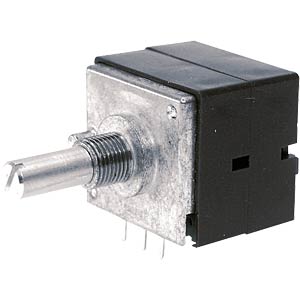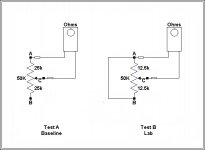We don't know how to build an ideal circuit, so R3 may still be required. I suppose that under some circumstances R3 could make things worse so be prepared to put a wire link in.
What are we saying here? We're going to put a wire link in every unity-gain opamp buffer's feedback, just in case?
If you are building a prototype then by definition you will always have provision for any change the circuit needs. If you are building a fully debugged circuit then you will already know whether a resistor is needed. The alternative is to build it as you hope might work, then rebuild it if it doesn't. I don't understand the fuss.counter culture said:In every unity-gain opamp circuit?
Since you posted the above I've read it about 40 times and still can't figure it out. Would you please explain further? Especially, "The source impedance presented by a 25k pot fed by a low-impedance source can be up to 6.25k after all, with a minimum of near-zero ohms," which defeats me entirely.
A lower value for the pot means less noise, less distortion, less crosstalk, less susceptibility to interferences.
Douglas Self found that, for a 5532 in voltage follower configuration, a 1 kOhm source impedance gives less distortion than none ("Small Signal Audio Design", second edition, page 133). His numbers : in identical conditions, at 10 kHz, 10 Vrms, distortion is 0.00053% with 1 kOhm input impedance, 0.0016% with 4.7 kOhm.
The ALPS 10 kOhm log pot is well considered.
RK27112-LOG10K: ALPS Drehpoti., High-End, 6mm, stereo, 10K bei reichelt elektronik

I would have liked that ALPS provides the same kind of pots in 4.7 and 2.2 kOhm, lin and log, values.
Lower than 10k dual audio taper vol pots seem to be rare.
I have not found any.
This is where switched attenuators come into their own.
One can build up any impedance/resistance to suit any circuit.
I have not found any.
This is where switched attenuators come into their own.
One can build up any impedance/resistance to suit any circuit.
Lower than 10k dual audio taper vol pots seem to be rare.
They are needed if you plan to build the two most recent Self's preamps (Elektor 1 kOhm, Linear Audio 4.7 kOhm).
Some low resistance lin and log pots :
Code : c510 potentiom-#232tre professionnel axe m-#233tal de 6mm piste cermet. fab:vishay
St Quentin radio: Prix Potentiomètre et P11 - Sfernice Potent. Vishay stéréo logarithmique
Low cost :
PO6S-LOG 1,0K: Drehpoti. logarithmisch, 6mm, stereo 1,0 k-Ohm bei reichelt elektronik
Last edited:
If you are building a prototype then by definition you will always have provision for any change the circuit needs. If you are building a fully debugged circuit then you will already know whether a resistor is needed. The alternative is to build it as you hope might work, then rebuild it if it doesn't. I don't understand the fuss.
You're talking about a lot of real estate, tracking and components. I very much doubt the guys at Elector followed the first procedure when laying out Doug Self's parallel 5532 amp. Far more likely the second, build it like your previous experience leads you to think it might work, then rebuild it if it doesn't.
I think you've got a reasonable expectation that you can build an NE5532 buffer without this component, and have it work.
Well you could knock me over with a feather. Who knew? Not me, or if I ever did I forgot, which is likely.
For those who don't have a meter and a few pots handy, a lab report is posted below. The lowest value is, of course, zero.
Thanks Mooly, and thanks also DF96, for clarifying this. Live & learn.
.
Attachments
- Status
- Not open for further replies.
- Home
- Source & Line
- Analog Line Level
- Unity gain opamp circuit
